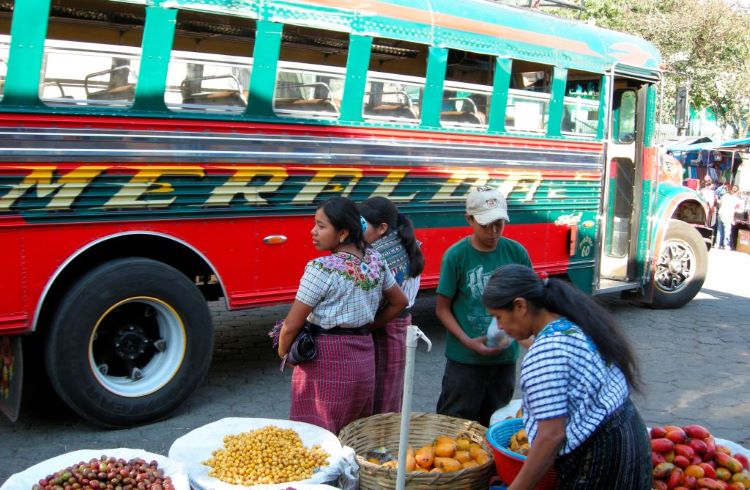Getting Around Guatemala: Chicken Buses & Other Transport
Traveling on a brightly painted “chicken bus” is a uniquely Guatemalan experience. But there are plenty of other forms of transportation available, including van shuttles and domestic flights. Guatemala expert Michael Shapiro shares his tips.
Shares
 Photo © Getty Images / StreetFlash
Photo © Getty Images / StreetFlash
Riding on one of Guatemala’s brightly painted “chicken buses” is an inexpensive way to get around, connect with locals, and experience a genuine slice of indigenous culture. Yet it’s not the only kind of transportation in Guatemala: there are van shuttles, taxis, and more upscale long-haul buses that cater to travelers. Uber has become a popular option, and there are flights within the country – for example, from Guatemala City to the Mayan ruins at Tikal – that can be relatively affordable.
Guatemala's famed “chicken buses”
Not only are these buses cheap – under Q15 (US $2) for a short trip, Q40 to Q60 (US $5-$8) for a three-hour ride from Antigua to Lake Atitlan – they’re a genuine window into Guatemalan life. Which is not to say riding a chicken bus is easy. They’re generally crowded (there’s a local joke: “How many people can fit in a Guatemalan bus? Dos mas, dos mas!”) and they don’t have seat belts. But the aisles can be packed so even as the bus careens around curves, you’re unlikely to be swept off your seat. And if you have a seat, consider yourself lucky.
Most chicken buses began their lives as US school buses. School districts typically sell these buses after 10 years to people in developing countries. Many are driven south to Guatemala where they’re overhauled mechanically (smog reduction devices are typically removed, sometimes mufflers too, so they’re loud) and boldly decorated. They’re so named because villagers years ago often traveled to and from markets with chickens.
The buses, known locally as camionetas, move slowly up Guatemala’s vertiginous slopes, often too fast downhill on two-lane roads with no guardrails. Be advised most don’t have toilets so use the facilities before you board. For longer rides bring snacks and potable water; if you’re feeling adventurous you might buy treats such as dried mangoes that vendors hoist to bus windows on poles; other sellers sometimes board the bus and sell their goods, then exit at the next stop.

If you’re carrying a backpack or luggage, the driver’s assistant will take it from you and tie it to the roof rack along with the baskets and bundles of the local riders. The first time I traveled in Guatemala, I was hesitant to release my pack, wondering if I’d ever see it again, but there’s simply not enough room inside to allow people to carry on more than a daypack. As I descended the driver’s assistant brought my pack down and tossed it to me as the bus rumbled off.
Note you don’t have to go to the bus station to get a bus. For example, if you’re in Guatemala City on the heavily traveled Pan American Highway, there are bus stops along the route. Most buses are privately owned, so they’re eager to pick up as many passengers as possible.
Safety concerns and advice
Whether you’re taking chicken buses or other ground transit, it’s best to leave early and arrive in daylight. It’s safer to travel by day for two reasons. Drivers can see hazards such as big potholes, cows in the road, or oncoming vehicles, some of which have weak or dead headlights. And in daytime, it’s less likely that a bus or van will be held up by bandits.
For long trips this means leaving at dawn or not long after; you want to plan to arrive by mid-afternoon. In case of delays, which are common, this provides a margin of a couple of hours to allow for a daylight arrival.
Organized crime is a fact of life in Guatemala; occasionally drivers who don’t pay off gangsters are targeted. If there’s a holdup, this can affect passengers as well, so pay attention to advisories from authorities such as the US State Department on areas to avoid. More important, talk to local people in Guatemala, such as hotel managers and shopkeepers, to seek safety advice. Generally speaking, well-traveled routes such as the highway leading from Guatemala City to Quetzaltenango tend to be safer than remote rural roads in areas with few tourists.
Whether you travel on chicken buses or shared van shuttles, don’t bring valuables such as jewelry, which advertise you as a wealthy foreigner. And don’t show or count large amounts of money in public; carry small bills.
Other transport options in Guatemala
Often the best balance of time, money, and safety is a shared van. These cater to travelers and will pick you up, for example, at your hotel in Antigua and drop you at your hotel in Panajachel (Q193/US $25 as of April 2022, about three times as expensive as the chicken buses).
On this popular route, the van will probably stop at other hotels to pick up fellow travelers, making the trip in about three hours. This will save time and a transfer: if you take a chicken bus from Antigua to Panajachel, you’ll probably have to disembark at Encuentros, then a board different bus down to Pana.
A service called GuateGo lists van shuttles throughout the country, but there may be other van options not listed here.
GuateGo is a good option for arrival at Guatemala’s airport. I recommend getting out of the city the same day and staying in the walkable colonial town of Antigua. The ride takes 50 minutes if there’s no traffic, an hour or more if you hit congestion. Try to book a flight that touches down in Guatemala between dawn and 4pm so you have time to get to Antigua in daylight. Overnight flights that arrive early morning can be a good option if you don’t mind a red-eye.
You can book an airport shuttle through Viator.
To see the remarkable Mayan ruins at Tikal, the best option is the hourlong flight from Guatemala City (usually Q770/US $100 or more roundtrip) if you can afford that. A Greyhound-style bus trip (these have toilets) may be as little as US $25, but it’s an arduous 10-hour ride. Some buses travel overnight; locals say these are relatively safe as the route is well patrolled.
And yes, Uber has come to Guatemala. Uber serves Guatemala City and you can book an Uber driver in advance to pick you up at the airport. Uber cars rarely have the audacious colors or blaring music of chicken buses, but they’ll zip you directly to your destination.
Cars and vans are available to rent in Guatemala, but this is not recommended until you’ve been in the country for some time and become familiar with its roads and aggressive driving style.
Related articles
Simple and flexible travel insurance
You can buy at home or while traveling, and claim online from anywhere in the world. With 150+ adventure activities covered and 24/7 emergency assistance.
Get a quote


No Comments